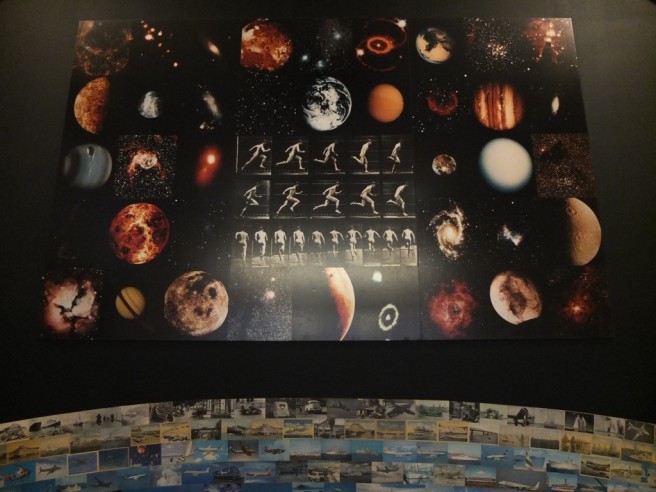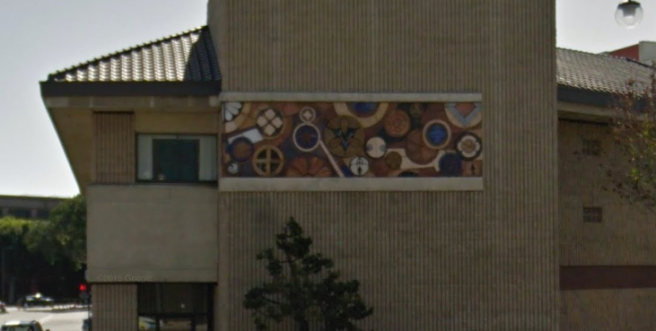
The landscape of Los Angeles is full of murals. Occupying as they do public rather than private space, their creators have to assume at their creation that their existence is temporary. They’re rarely respected by artless taggers and once sufficiently damaged, graffiti removers usually obliterate them with their own artless paint jobs. Increasing they’re annihilated by community colonizers, who move into old businesses and whose bourgeois aesthetic sensibilities prefer blank walls to murals. The lucky ones crack and fade in the sun unless they’re preserved or restored, which occasionally they are.
Because Los Angeles is the world’s great pan-Asian city and because it’s currently Asian Pacific American Heritage Month, I thought it would be nice to highlight the murals created by APA artists. I’ve listed and mapped the works of which I’m aware but I’d love to add more, whether they’re commissioned artworks, street art, commercial murals, &c. So please leave suggestions in the comments.
*****
Chinese Celestial Dragon — Tyrus Wong, 1941 (951 N. Broadway)

The Chinese Celestial Dragon mural was painted in 1941 by artist Tyrus Wong, a Chinese-born artist and kite maker celebrated for his work on the Disney film, Bambi (1942). In 2015, when he was 104, he was the subject of a biographical documentary titled Tyrus. The mural is located on a tower at New Chinatown Center Plaza and was restored by Fu Ding Cheng in 1984. It’s served by Metro‘s Gold, 28, 45, 83 and LA DOT’s DASH Downtown B lines.
Epoch — Patrick Nagatani, 1996 (800 N. Alameda St.)

Patrick Nagatani’s collage Epoch (1996) depicts ships, trains, and other forms of transit. It also includes a series of Eadweard Muybridge photos from 1887, which though safe enough for Victorians proved so offensive to some in the 1990s that they were briefly covered with a plastic tarp. Epoch is located inside Union Station and is thus served by all of the transit lines which pass through Union Station.
Gintong Kasaysayan, Gintong Pamana — Eliseo Silva, 1995 (1600 Beverly Blvd.)

Eliseo Silva’s large Gintong Kasaysayan is located in Unidad Park, which began life as the the Candy Chuateco Community Garden in 1993. The mural and park are served by Metro’s 14/37 line.
Home is Little Tokyo — Tony Osumi, Sergio Diaz, and Jorge Diaz, 2005 (S. Central Avenue & E. 1st St.)

The mural Home is Little Tokyo was designed by Tony Osumi with substantial input from the Little Tokyo community and depicts several eras and aspects of the neighborhood. It’s served by Metro’s Gold and LA DOT’s DASH A lines.
Los Angeles Wholesale Produce Market mural — Thomas Suriya, 1986 (1601 E. Olympic Blvd.)

Thomas Suriya’s two large murals at the Wholesale Produce Market cover 613 square meters and depict giant floating produce. Most produce in the Southwest passes through the Produce Market, a vast complex the new owners of which hope to transform into a mixed-use community known as Row DTLA. The market and mural are served by Metro’s 53 and 66 lines.
The Party at Lan-Ting (Chinatown Public Library)

Shiyan Zhang‘s 1991 mural, The Party at Lan-Ting, is located on the exterior wall of Chinatown Public Library. The mural depicts 4th century calligrapher Wang Xi Zhi drinking wine, writing a poem, and hosting a party. It’s served by Metro’s Gold, 81, 90/91, 94, 96, and Rapid 794 lines as well as LA DOT’s Commuter Express 419 line.
Picture of Viewing Waterfalls in Summer Mountains, Palace in Heaven, and Four Beauties Catching Swimming Fish, anonymous, 1968 (913 N. Broadway)

Three scroll-like tile murals, in three different styles, were created by an unknown artist in 1968 and adorn a wall of a building that’s been home to Plum Tree Inn since 1979. The mural is accessible via Metro’s Gold, 28, 45, 83, and LA DOT’s DASH Lincoln Heights/Chinatown lines.
Sen Bana No Saki (Thousand Blossoms) — Kazuko Kayasuga Matthews, 1981 (400 E. 2nd St.)

Kazuko Kayasuga Matthews’s Sen Bana no Saki mural adorns the western wall of Little Tokyo’s Honda Plaza. The abstract designs represent emblematic Japanese family crests known as mondokoro (紋所) or kamon (家紋). It’s served by Metro’s Gold and LA DOT’s DASH A lines.
Senzo — Jerry Matsukuma, 1981 (356 E. 1st St.)

Jerry Matsukuma’s Senzo is a six meter tall tile mural that incorporates text and photography to relate the experience of Little Tokyo’s Issei pioneers. It’s served by Metro’s Gold Line.
Shades of Chinatown — Steven Wong and others, 2003 (421 W. College St.)

Shades of Chinatown was created by Steven Wong with help from the Youth Leadership Council of Chinatown and Lincoln Heights and is designed to portray Chinatown’s diversity. It’s served by Metro’s Gold, 81, 90/91, 94, 96, and Rapid 794 lines.
*****
Lost Asian-Angeleno murals include Dong-in Park’s Koreans (1989 – 690 Wilshire Pl.) and Hitoshi Yoshida’s Flight of the Angel (1989 – 407 E. Third St.). Carol Nye’s Chinese American Women in L. A. (1994 – 711 N. Main St.), was taken down from Metro Plaza Hotel in 2000.
Special thanks: Public Art in LA
See also: Mural Conservancy of Los Angeles
*****
Eric Brightwell is an adventurer, writer, rambler, explorer, cartographer, and guerrilla gardener who is always seeking writing, speaking, traveling, and art opportunities — or salaried work. He is not interested in writing advertorials, clickbait, listicles, or other 21st century variations of spam. Brightwell’s written work has appeared in Amoeblog, diaCRITICS, and KCET Departures. His work has been featured by the American Institute of Architects, the Architecture & Design Museum, Boom: A Journal of California, the Craft & Folk Art Museum, Form Follows Function, Los Angeles County Store, Skid Row Housing Trust, and 1650 Gallery. Brightwell has been featured in the Los Angeles Times, Huffington Post, Los Angeles Magazine, LAist, Eastsider LA, Boing Boing, Los Angeles, I’m Yours, and on Notebook on Cities and Culture. He has been a guest speaker on KCRW‘s Which Way, LA? and at Emerson College. Art prints of his maps are available from 1650 Gallery and on other products from Cal31. He is currently writing a book about Los Angeles and you can follow him on Facebook, Instagram, and Twitter.
Click here to offer financial support and thank you!


This is a great collection, but I notice that no female Asian American artists are included. Can you update the article with some?
LikeLike
Ah thanks! While I included female Asian American artists in the pieces on public art, sculpture, and artchitecture; I’m afraid that I don’t know of any female Asian American muralists. Do you? If you or anyone else does, let me know.
I’m also working on a piece about Asian Angeleno artists, in general, but that probably won’t be published for a bit.
LikeLike